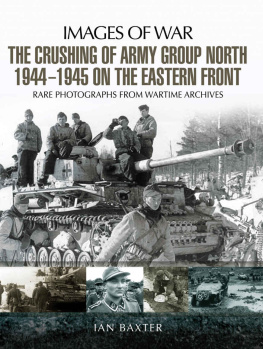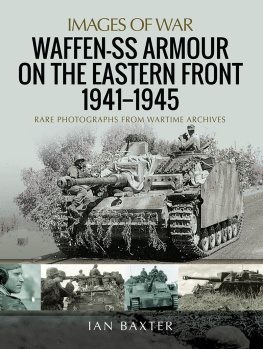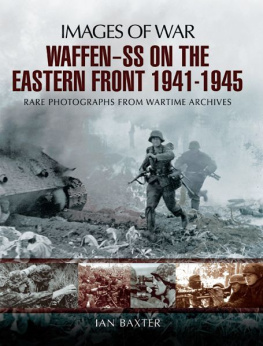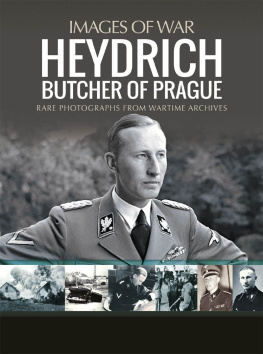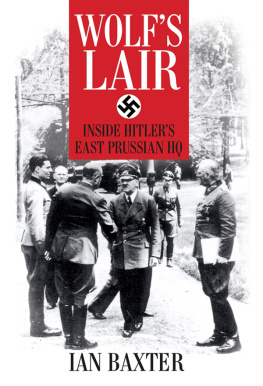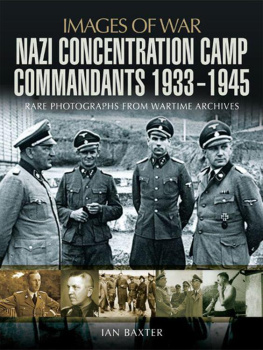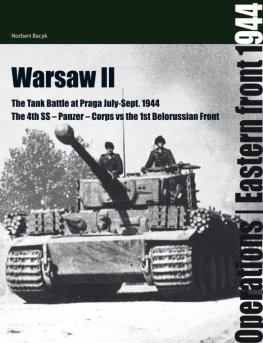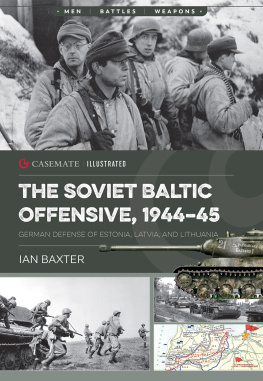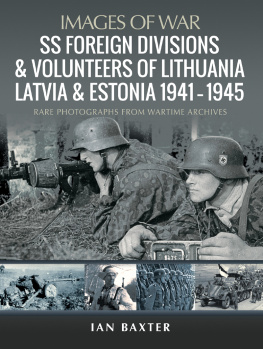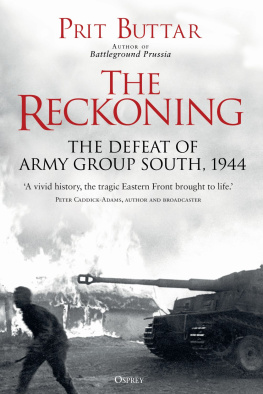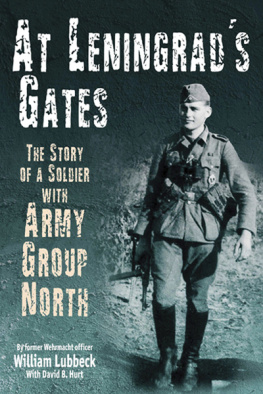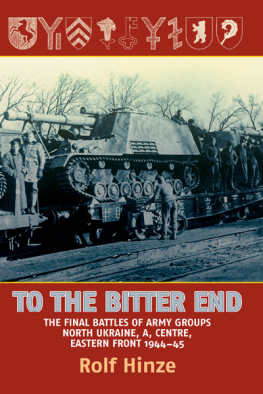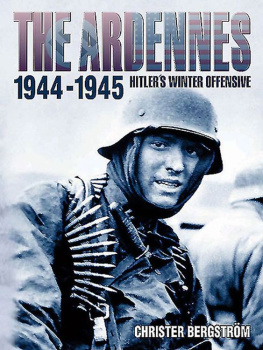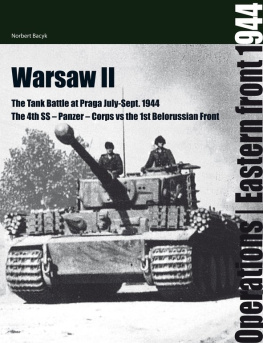IMAGES OF WAR
THE CRUSHING OF ARMY GROUP NORTH 1944 1945
RARE PHOTOGRAPHS FROM WARTIME ARCHIVES
Ian Baxter
First published in Great Britain in 2017 by
PEN & SWORD MILITARY
An imprint of
Pen & Sword Books Ltd
47 Church Street
Barnsley
South Yorkshire
S70 2AS
Copyright Ian Baxter, 2017
ISBN 978-1-47386-255-5
eISBN 978-1-47386-257-9
Mobi ISBN 978-1-47386-256-2
The right of Ian Baxter to be identified as author of this work has been asserted by him in accordance with the Copyright, Designs and Patents Act 1988.
A CIP catalogue record for this book is available from the British Library.
All rights reserved. No part of this book may be reproduced or transmitted in any form or by any means, electronic or mechanical including photocopying, recording or by any information storage and retrieval system, without permission from the Publisher in writing.
Pen & Sword Books Ltd incorporates the imprints of Pen & Sword Archaeology, Atlas, Aviation, Battleground, Discovery, Family History, History, Maritime, Military, Naval, Politics, Railways, Select, Social History, Transport, True Crime, and Claymore Press, Frontline Books, Leo Cooper, Praetorian Press, Remember When, Seaforth Publishing and Wharncliffe.
For a complete list of Pen & Sword titles please contact
PEN & SWORD BOOKS LIMITED
47 Church Street, Barnsley, South Yorkshire S70 2AS, England
E-mail:
Website: www.pen-and-sword.co.uk
Contents
About the Author
I an Baxter is a military historian who specialises in German twentieth century military history. He has written more than twenty books including Afrika-Korps ; Auschwitz Death Camp ; Belsen and its Liberation ; Blitzkrieg in the West ; The Crushing of Poland ; Final Days of the Reich ; German Army on the Eastern Front The Advance ; German Army on the Eastern Front The Retreat 19431945 ; German Guns of the Third Reich ; Himmlers Nazi Concentration Camp Guards ; Hitlers Defeat on the Eastern Front ; Hitlers Headquarters 19391945 ; Hitlers Heavy Panzers 194345 ; Hitlers Mountain Troops 19391945: The Gebirgsjager ; Hitlers Panzers ; Nazi Concentration Camp Commandants 19331945 ; Panzer Divisions at War 19391945 ; Retreat to Berlin; The U-Boat War 19391945 ; Waffen-SS on the Eastern Front 19411945 and Waffen-SS on the Western Front 19401945 . He has written over 100 journals including Last days of Hitler , Wolfs Lair , Story of the V1 and V2 Rocket Programme , Secret Aircraft of World War Two , Rommel at Tobruk , Hitlers War with his Generals , Secret British Plans to Assassinate Hitler , SS at Arnhem , Hitlerjugend , Battle of Caen 1944 , Gebirgsjger at War , Panzer Crews , Hitlerjugend Guerrillas , Last Battles in the East , The Battle of Berlin , and many more. He has also reviewed numerous military studies for publication, supplied thousands of photographs and important documents to various publishers and film production companies worldwide, and lectures to various schools, colleges and universities throughout the United Kingdom and Ireland.
Chapter One
A Brief History
A t dawn on 22 June 1941, along an 1,800-mile-long invasion front, 3 million German soldiers on the frontier of the Soviet Union unleashed one of the most brutal conflicts of the twentieth century Operation Barbarossa. Directing this invasion of Russia was Feldmarschall Ritter von Leeb, commander of Heeresgruppe Nord (Army Group North), Feldmarschall Fedor von Bock in the centre and Feldmarschall Gerd von Rundstedt in the south. Von Leebs Heeresgruppe Nord was given the task of destroying the Red Army fighting in the Baltic region. Hitler stipulated on the eve of the invasion that the German objective was to thrust across East Prussia, smashing Soviet positions along the Baltic, liquidating the bases of the Baltic Fleet, destroying what was left of Russian naval power and capturing Kronstadt and Leningrad. Once the city had been razed to the ground, the German armies could sweep down from the north while the main force closed in from the west. With 500,000 men at Leebs disposal, comprising almost thirty divisions, six of them armoured and motorized with 1,500 Panzers and 12,000 heavy weapons, plus an air fleet of nearly 1,000 planes, he was determined to strike along the Baltic coast and dispose of the Russian force once and for all.
Leebs rapid two-pronged offensive along the Baltic opened up at first light on the morning of 22 June 1941. His force, consisting of 16th and 18th Armies, smashed through the Soviet defences. Russian soldiers stood helpless in its path, too shocked to take action. Over the coming weeks, German troops of Army Group North continued to chew through enemy positions, heading through Lithuania, Latvia and Estonia, straight towards their objective Leningrad. Fortunately, the earth was baked under the blistering summer heat and Leebs army was able to advance rapidly through the Baltic states.
By 10 July, Leebs units broke south of Pskov and rolled toward Luga. At the rate they were advancing, they would need no more than nine or ten days to reach the outskirts of Leningrad. But following their surge of success, the Wehrmacht were losing momentum. Not only were their supply lines being overstretched, but enemy resistance began to stiffen on the road to Leningrad. In a desperate attempt to blunt the German advance and prevent them from reaching the imperial city, brigades of Russian marines, naval units, and more than 80,000 men from the Baltic Fleet were hastily sent into action against Leebs forces. These Russian soldiers were now the sole barrier between Leningrad and the Germans. Although the advance was hampered by these Russian forces, by the end of August 1941, Leebs Panzers were finally within sight of Leningrad. The terrified civilians left inside the city walls were now going to endure one of the most brutal sieges in twentieth century history.
As the summer of 1941 passed and the Germans drew closer to the city gates, Leningraders were given the grim order to defend their city to the death. Although Leebs forces had arrived within shelling distance of Leningrad, the advance had not gone as planned. Already units had been badly disrupted and were mired on the Leningrad Front by stiffening resistance.
By 17 September, the Moscow Front could wait no longer for victory in the north. The shift of the main weight, the powerful 41.Panzer-Korps which Leeb required to sledgehammer his way to the outskirts of Leningrad, was taken out of line and ordered to the Moscow Front. Without the 41st Panzer Corps the whole dynamics of Army Group North had altered. There would now be no attack on Leningrad. Instead, Hitler ordered that the city would be encircled and the inhabitants defending inside would be starved to death. During October and November 1941, some ten German divisions were tied down around the city. For the next year German troops of Army Group North fought a series of bloody battles to hold their positions around Leningrad. Although they had managed to blunt Russian penetrations through their lines with the sacrifice of thousands of men killed and wounded, the battle had in fact absorbed all the available resources of the 18th Army and elements of the 11th Army, which had resulted in the planned assault on Leningrad being abandoned.
Now, a sense of futility and gloom gripped the German soldier in Army Group North. Thousands of soldiers had been killed and by mid-October 1942, they found themselves substantially in the same position they had been in spring. From the Volkhov River to the Gulf of Finland the front was reminiscent of the First World War with a string of trenches and shell holes in which gains and losses could be measured only in yards. Because of defeats in southern Russia, German forces were now compelled to go on the defensive against growing resistance. Despite the prevailing conditions and the daily shelling, Leningrad gradually regained strength and became a strong fortress, capable of withstanding a further year and a half of siege and every enemy attempt to destroy it. Costly as this defence was, it managed to pin down huge parts of Army Group North that were desperately needed elsewhere to plug the crumbling front. When news of the Red Armys breakthrough came on 18 January 1943, it was greeted by soldiers of Army Group North with trepidation. From their relatively inactive front they watched anxiously as the Russians began increasing their attacks. Commanders in the field were well aware that if the hold on Leningrad were broken, Army Group North would eventually lose control of the Baltic Sea. Finland would be isolated; supplies of iron ore from Sweden would be in danger, and the U-boat training programme would be seriously curtailed. It was now imperative that the troops held the front and waged a static battle of attrition until other parts of the Russian front could be stabilized.
Next page
